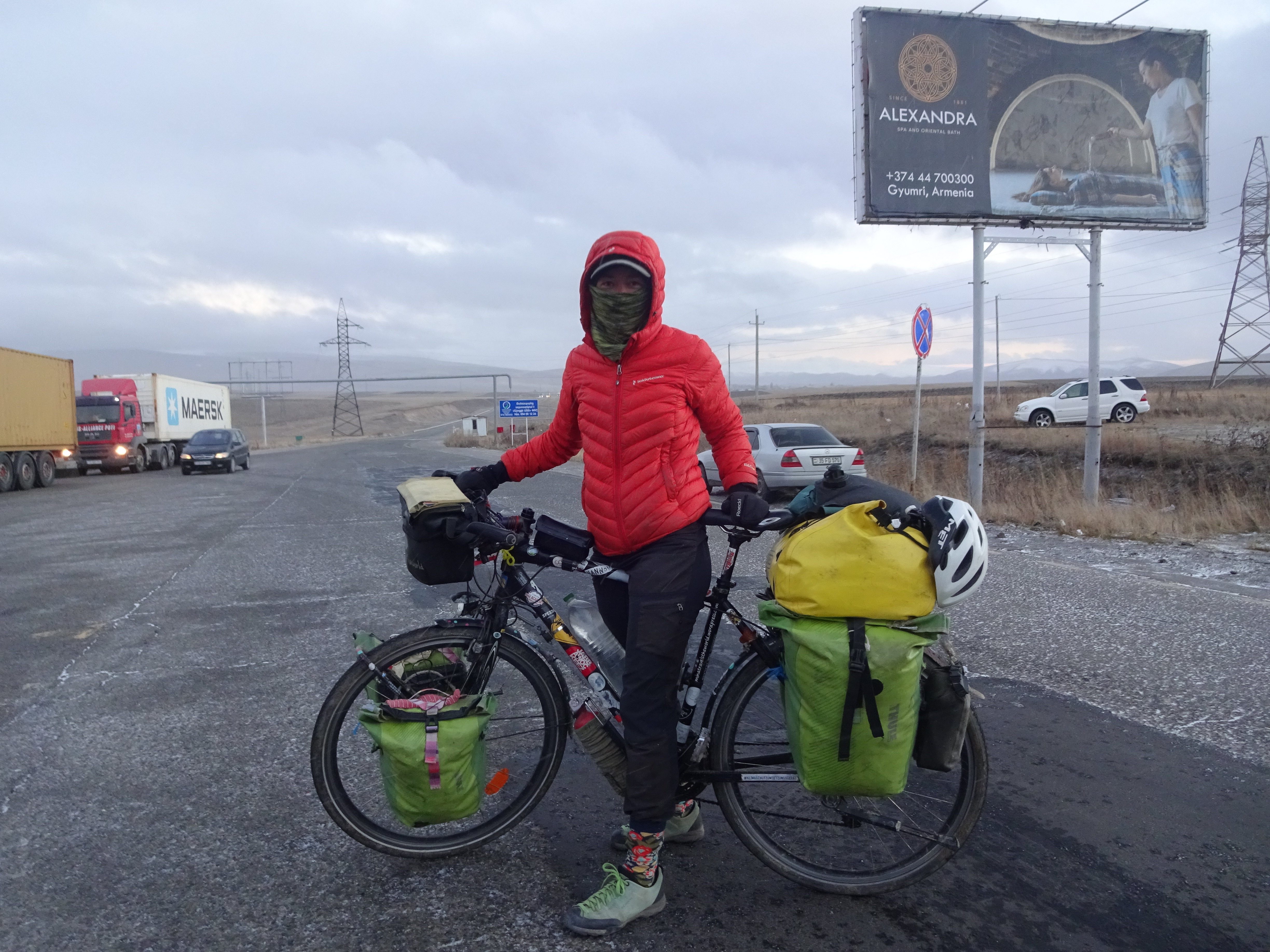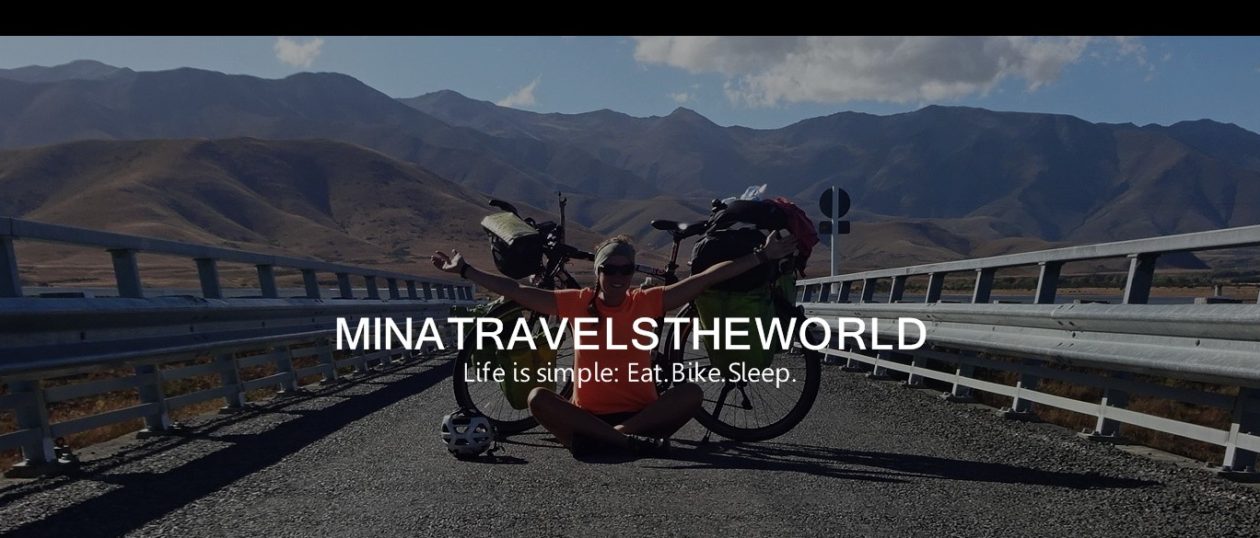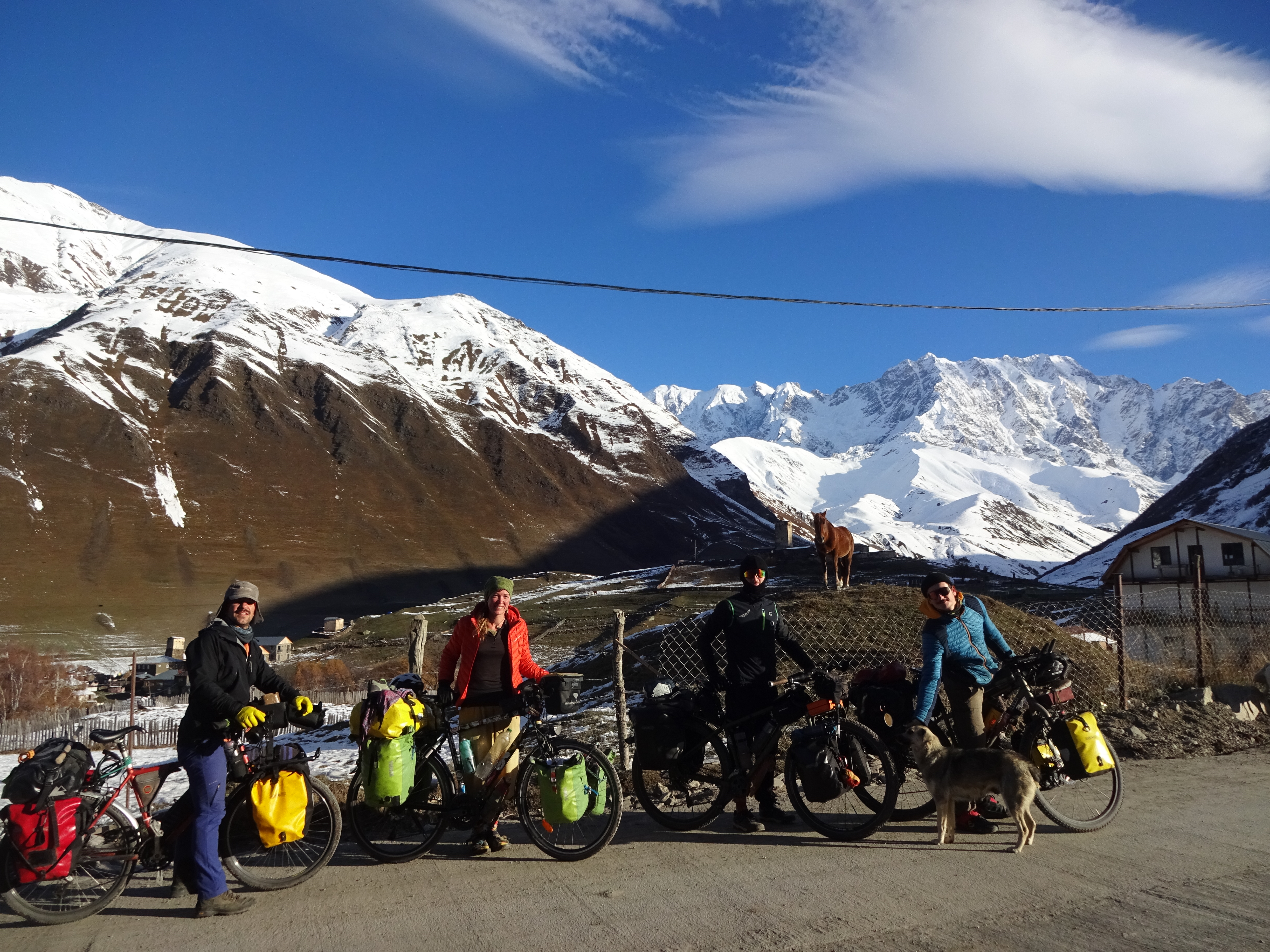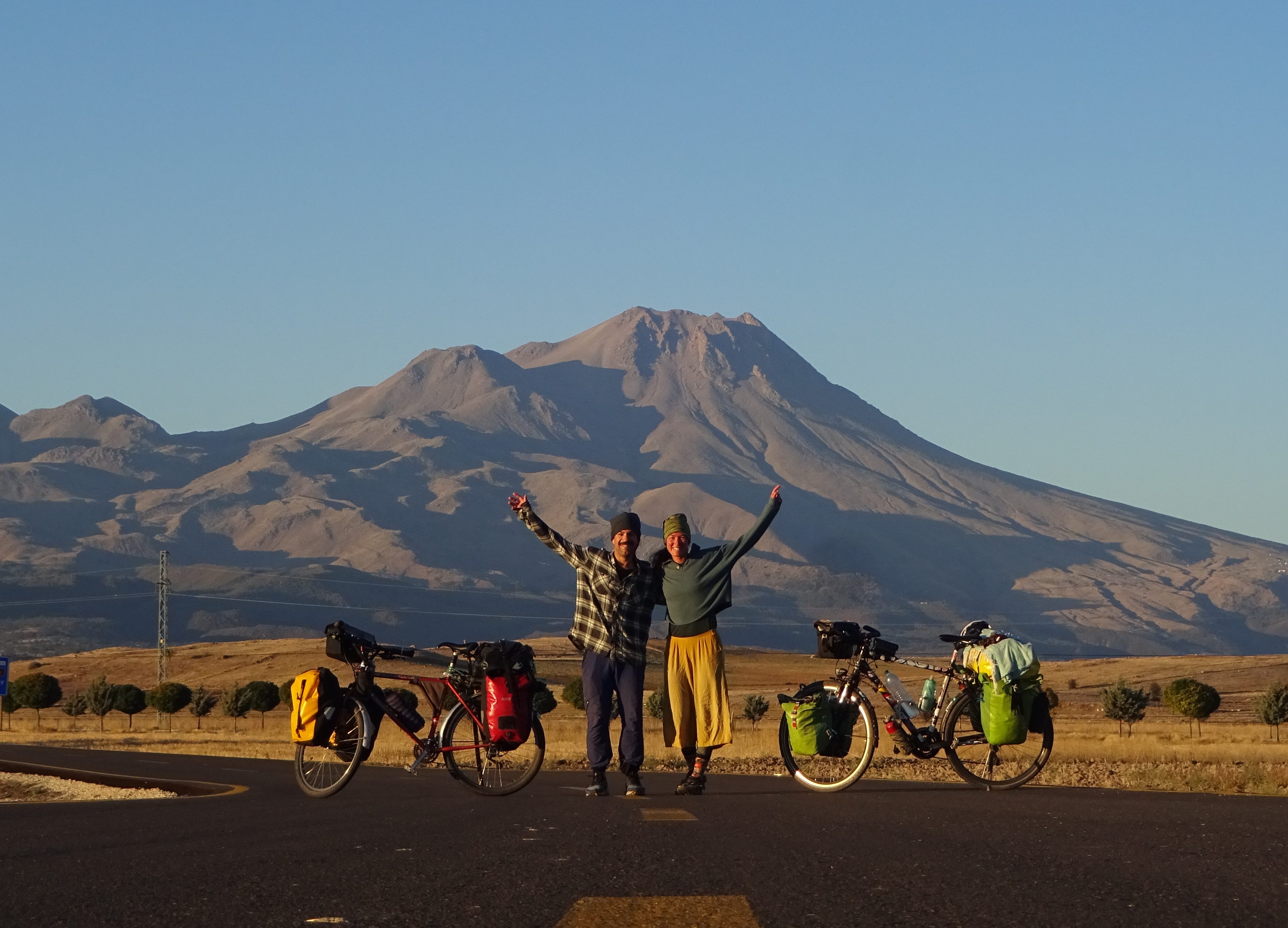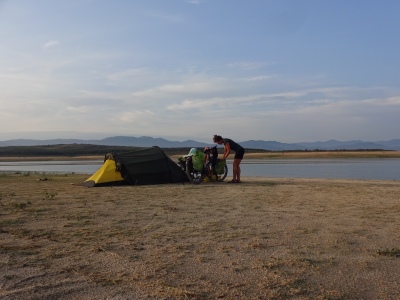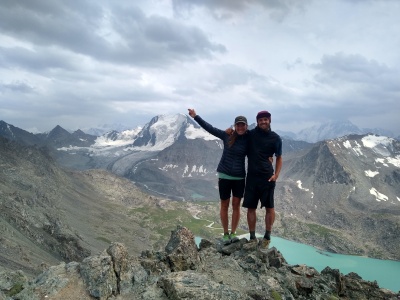I cross the border to Armenia on the 5th of November. It´s already evening and the light is fading. It´s windy, snowing a little bit and it´s freezing. I do find some abandoned houses and the old border station but none of those builings has windows or a closed room. It´s too cold and I´m hoping to find something a little warmer. Even the water in my plastic bottle freezes while cycling. I arrive in Bavra, the first village after the border. There are just a few houses but I find a little shop, where I go in. I greet the man behind the desk and put the following message in my offline translation app: „Hello, I am travelling on my bicycle. I am looking for a shelter for the night. It is very cold outside. Maybe I can sleep in the church?“ The church is right next to the shop. While I type the message on my phone, the men gives me two chocolate candies and says ´Welcome to Armenia´.
He reads the translation and immediately opens a draw under the counter to take out a key. He gives me a sign to follow him. We walk behind the house where the shop is in, to another very little house on the field. Inside, there are two rooms, one empty one on the right side and one on the left side with a bed, a table and a chair inside. Even though there is no heating or electricity, it already feels much warmer inside. He lids up a big candle on the table, shows me how I can lock the door from the inside and leaves. I´m incredibly gratefull. I start cooking dinner and put my tent up inside to have it even warmer. I sleep very well. What a nice start in my 50th country.
The average elevation in Armenia is above 1800m. The terrain is mostly mountainous, with Aragats as the highest peak (4090m). There is no low land, which means for me, that temperatures probably won´t get any warmer while I am there. The landscape is beautiful though and the light on these late atumn days is warm and welcoming. Just like in Georgia, I keep finding nice shelters for the night along the way and also get invited in once, after chatting to a guy on the street. His wife prepares some very tasty dinner and I enjoy the warmth of the fireplace.
For many years now, my parents get a postcard from every country I travel to. But it turns out that in Armenia it becomes a little challenge. The first post office in a village I pass through, doesn´t have stamps at all and sends me to the next bigger city. Luckily it´s on my way. Since I don´t have a postcard from Armenia yet, I show the girl at the counter one from Georgia and tell her, that I would like to send it to Germany. Very confident she looks something up on her phone and then sells me eight stamps. The value of one single stamp is very low, so that I need eight of them. The next day I finally find a postcard. While I keep going, I write a nice message on the card and want to drop it off some other day at another post office along the way. There, people don´t seem to understand what I want. They propably think:´Why would this girl want to send a piece of paper to Germany´. None of the ladies working there can asure me, that it is possible to send it and that it will arrive in Germany. I´m confused. It´s a post office, so what are they doing there? It felt like the girl, who sold me the stamps, knew, what she was doing. After asking multiple times at this last post office, still not getting a propper answer, I take the postcard and leave. I decide that it´s probably safer to give it to my parents in person one day, instead of leaving it at the postoffice.
In the end I only spend a little more than a week in Armenia, before I need to head back to Georgia to get to Tbilisi in time. It is for sure a place I would want to go back to in summer one day. Exlporing the mountains and going a little further south in Armenia must be so nice.
I get to Tbilisi on November 15th to apply for my new passport and meet up with Hector again to explore the city for a few days.
From there I´m heading to the very east of the country. The traffic is bad, not only around Tbilisi. Georgians drive very rapid, risky and not carrying much about a cyclist on the road or sometime not even about other cars. In Georgia as well as in Armenia, I feel very unsafe on the road and I´m glad nothing happens during the time I am cycling in these countries. Every time, I find a quiet small road or at least a road with a big shoulder, which is rare in Georgia, I am relieved.
Regarding the traffic and the behavior of the drivers, it has been the worst country since my departure in Morocco and it´s not just me with this impression. Other cyclists report the same feeling.
In the very east of Georgia, I am doing a three day loop through the Vashlovani National Park. It is a really remote area and you need to get a special permit in the last town you come through, since the park is right next to the border to Azerbaijan. There are only dirt roads, mostly in a not very good quality. Sometimes it´s just a sandy track through a riverbed. It´s worthwhile though. It´s quiet, no people or traffic around and the landscape is impressive.
Close to Dedoplistskaro I get to meet Asia, a woman, where I filled up my water, but who I ended up staying with for three days. In a short amount of time, I get to know a lot of people in the village. And even though we can only communicate by using google translate, I spend some very special, interesting and fun days with her. I learn how to make the typical Georgian sweets, called ´Churchkhela´, I help to brew the Georgian liquor, called ´Chacha´ and I learn how to make Khinkali, the Georgian dumplings stuffed with meat or vegetables and spices. It´s a very unique, pure georgian experience.
In georgian villages the residents seem to know and to help each other much more than in Germany for example. As well people are more self sufficient, which might have financial reasons. A lot of them grow their own vegetables or fruits, which they preserve for the winter. They might have one or multiple cows, pigs and chickens and produce cheese, yogurt or butter.
I start wondering about our society. Once you have money, you can buy everything you want and maybe have an easier live because of that. You are less busy, because you can just go to a shop or a dealer to buy something instead of producing or building it yourself. But are you happier and is it better? Didn´t live become too easy in some countries or regions? Isn´t it too luxurious? Do we maybe have so many hobbies, because we would be bored otherwise? The shopping gets delivered, the floor gets cleaned by a robot, the dishes get cleaned by a dishwasher, the laundry done by a washing mashine. There are multiple ways to look at this, but I think it´s important to realise every once in a while, how luxurious most of the lifes in central Europe are. And also how insignificant some of our problems are. Travelling is a good way to change the perspective on that.
Before heading back to Kutaisi, I´m doing another detour to the north of Georgia, right next to the russian border. It´s getting colder and colder at night and on some days I can even build a snowman.
I hitchhike over the Jvari pass. The weather is too cold and unpleasant for cycling and traffic is bad. It´s one of the main borders to Russia and there are hundreds of big trucks on the narrow mountain road. The weather changes once I´m on the northern side of the pass. It´s sunny and the whole valley towards Kazbegi National Park is covered in a thick layer of snow. The temperatures are freezing but cycling through this landscape is so rewarding. I check into a guesthouse in Stepantsminda for three nights, to have a warm place to stay, when the temperatures drop down to -18°C at night. It´s nice to explore the winterwonderland for a few days.
Around the 7th of December, I´m heading to Kutaisi, partly hithchiking, some parts cycling and on stretch by train.
It´s funny to realise, that once you´ve managed some extrems, everything else seems so easy afterwards. Talking about temperature for example: If you´ve camped a few nights with minus 5°C down to minus 10°C and then you have a night with plus 10°C, it feels like summer. Or the same happens with the judgement of road quality. If you´ve cycled on a bad gravel road, or in sandy riverbeds, sometimes not even able to cycle, then any asphalt road, it doesn´t matter how many potholes there are, feels like an well prepared Autobahn.
From Kutaisi I catch a flight to the Alps the middle of December. I am only flying with handluggage. My bike and my equipment is stored at the house of a warmshowers host. It was kind of a spontaneous idea, but since I will keep travelling, heading to the east, I want to see my parents, my sister and my best friend. I don´t feel the need of returning ´home´to the north of Germany though, so I am going to meet everyone down in the Alps, my second home.
Well, other people fly somewhere to go on vacation, I fly home to see my family. I enjoy the break of my trip and the comfort of just staying indoors on the couch once the weather is bad. But I am also excited, what the year 2025 will bring. 2024 has been amazing- Thanks to everyone, who is part of this adventure.
I return to Georgia on January 18th and guess what… it´s pouring rain.
PICTURES// BILDER: please click here!
.
.
.
Am 5. November fahre ich über die Grenze nach Armenien. Es ist bereits Abend und dämmert. Zudem ist es windig, schneit ein wenig und eiskalt. Kurz hinter der Grenze finde ich zwar einige verlassene Häuser und die alte Grenzstation, aber keines dieser Gebäude hat Fenster oder einen geschlossenen Raum. Es ist zu kalt und ich hoffe, etwas Wärmeres zu finden. Sogar das Wasser in meiner Plastikflasche gefriert während ich Radfahre. Ich komme in Bavra an, dem ersten Dorf nach der Grenze. Es gibt nur ein paar Häuser, aber ich finde einen kleinen Laden. Ich begrüße den Mann hinter dem Tresen und gebe die folgende Nachricht in meine Offline-Übersetzungs-App ein: „Hallo, ich bin mit dem Fahrrad unterwegs. Ich suche einen Unterschlupf für die Nacht. Es ist sehr kalt draußen. Vielleicht kann ich in der Kirche schlafen?“ Die Kirche ist gleich nebenan. Während ich die Nachricht in mein Telefon tippe, gibt mir der Mann zwei Schokoladen Pralinen und sagt „Willkommen in Armenien“.
Dann liest er die Übersetzung und öffnet sofort eine Schublade unter dem Tresen, um einen Schlüssel herauszunehmen. Er gibt mir ein Zeichen, ihm zu folgen. Wir gehen hinter das Haus, in dem sich der Laden befindet, zu einem weiteren sehr kleinen Haus auf der Wiese dahinter. Drinnen gibt es zwei Räume, einen leeren auf der rechten Seite und einen auf der linken Seite mit einem Bett, einem Tisch und einem Stuhl darin. Obwohl es weder Heizung noch Strom gibt, fühlt es sich drinnen schon viel wärmer an. Er zündet eine große Kerze auf dem Tisch an, zeigt mir, wie ich die Tür von innen abschließen kann und geht. Ich bin unglaublich dankbar. Ich fange an, das Abendessen zu kochen und stelle mein Zelt drinnen auf, damit ich es etwas wärmer habe. Ich schlafe sehr gut. Was für ein schöner Start in mein 50. Land.
Die durchschnittliche Höhe in Armenien liegt über 1800 m. Das Gelände ist größtenteils bergig, mit Aragats als höchstem Gipfel (4090 m). Es gibt kein Tiefland, was für mich bedeutet, dass die Temperaturen wahrscheinlich nicht wärmer werden, während ich dort bin. Die Landschaft ist jedoch wunderschön und das Licht an diesen spätherbstlichen Tagen ist warm und einladend. Wie schon in Georgien finde ich unterwegs immer wieder geschützte Übernachtungsmöglichkeiten und werde einmal eingeladen, nachdem ich mit einem Herren auf der Straße geplaudert habe. Seine Frau kocht ein sehr leckeres Abendessen und ich genieße die Wärme des Kamins.
Seit vielen Jahren bekommen meine Eltern aus jedem Land, in das ich reise, eine Postkarte. In Armenien wird das allerdings zu einer kleinen Herausforderung. Das erste Postamt in einem Dorf, durch das ich komme, hat gar keine Briefmarken und schickt mich in die nächstgrößere Stadt. Zum Glück liegt diese auf meinem Weg. Da ich noch keine Postkarte aus Armenien habe, zeige ich der Frau am Schalter eine aus Georgien und sage ihr, dass ich sie gerne nach Deutschland schicken möchte. Sehr zuversichtlich schaut sie etwas auf ihrem Handy nach und verkauft mir dann acht Briefmarken. Der Wert einer einzelnen Briefmarke ist so gering, sodass ich acht davon brauche. Am nächsten Tag finde ich endlich eine Postkarte. Während ich weiterreise, schreibe ich eine nette Nachricht auf die Karte und möchte sie an einem anderen Tag bei einem wieder anderen Postamt abgeben. Dort scheinen die Leute nicht zu verstehen, was ich will. Sie denken wahrscheinlich: „Warum sollte dieses Mädchen ein Stück Papier nach Deutschland schicken wollen?“ Keine der Damen, die dort arbeiten, kann mir versichern, dass es möglich ist, die Karte zu verschicken und dass sie in Deutschland ankommt. Ich bin verwirrt. Es ist ein Postamt, was also machen sie dort? Es hatte sich eigentlich so angefühlt, als wüsste die Frau, die mir die Briefmarken verkauft hat, was sie tut. Nachdem ich bei diesem letzten Postamt mehrmals nachgefragt habe und immer noch keine richtige Antwort bekomme, nehme ich die Postkarte und verabschiede mich. Ich entscheide mich dazu, dass es wahrscheinlich sicherer ist, sie eines Tages meinen Eltern persönlich zu geben, anstatt sie bei der Post zu lassen.
Letztendlich verbringe ich nur etwas mehr als eine Woche in Armenien, bevor ich nach Georgien zurückkehren muss, um rechtzeitig in Tbilisi zu sein. Es ist auf jeden Fall ein Ort, an den ich eines Tages im Sommer zurückkehren möchte. Die Berge intensiver zu erkunden und etwas weiter in den Süden Armeniens zu fahren, muss mega schön sein.
Ich komme am 15. November in Tbilisi an, um meinen neuen Reisepass zu beantragen. Zudem treffe ich mich noch mal mit Hector, um gemeinsam mit ihm für ein paar Tage die Stadt zu erkunden.
Danach fahre ich von dort in den äußersten Osten des Landes. Der Verkehr ist mühsam, nicht nur um Tbilisi herum. Die Georgier fahren sehr schnell, riskant und achten nicht wirklich auf Radfahrer, manchmal nicht einmal auf andere Autos. Sowohl in Georgien als auch in Armenien fühle ich mich auf der Straße sehr unsicher und bin froh, dass während meiner Reise in diesen Ländern nichts passiert. Jedes Mal, wenn ich eine ruhige kleine Straße oder zumindest eine Straße mit einem breiten Seitenstreifen finde, was in Georgien selten vorkommt, bin ich erleichtert.
Bezogen auf den Verkehr oder das Verhalten der Fahrer-innen, ist es das schlimmste Land seit meiner Abreise aus Marokko und nicht nur ich habe diesen Eindruck. Andere Radfahrer berichten von ähnlichen Erfahrungen und Gefühlen.
Ganz im Osten Georgiens mache ich einen dreitägigen Loop durch den Vashlovani-Nationalpark. Es ist ein sehr abgelegenes Gebiet und in der letzten Stadt, durch die man kommt, muss man sogar eine spezielle Genehmigung beantragen, da der Park gleich an der Grenze zu Aserbaidschan liegt. Es gibt nur unbefestigte Straßen, die meisten von nicht sehr guter Qualität. Manchmal ist es nur eine Sandpiste durch ein Flussbett. Aber es lohnt sich. Es ist ruhig, hat keine Menschen oder Verkehr und die Landschaft ist wunderschön.
In der Nähe von Dedoplistskaro lerne ich Asia kennen, eine Frau, bei der ich zuerst nur meine Wasserflaschen aufgefüllt habe, bei der ich dann aber letztendlich drei Tage bleibe. In kurzer Zeit lerne ich fast das halbe Dorf kennen. Und obwohl wir nur mit Google Translate kommunizieren können, verbringe ich einige sehr besondere, interessante und lustige Tage mit ihr. Ich lerne, wie man die typische georgische Süßigkeite namens ´Churchkhela´ herstellt, ich helfe beim Brauen des georgischen Schnapses, genannt ´Chacha´, und ich lerne, wie man Khinkali, die georgischen Teigtaschen, die mit Fleisch oder Gemüse und Gewürzen gefüllt sind, herstellt. Es ist eine einzigartige Erfahrung in Georgien.
In georgischen Dörfern scheinen sich die Bewohner viel besser untereinander zu kennen und einander viel mehr zu helfen als beispielsweise in Deutschland. Außerdem sind die Menschen unabhängiger, was finanzielle Gründe haben könnte. Viele von ihnen bauen ihr eigenes Gemüse und Obst an, das sie für den Winter konservieren. Zudem haben manche von ihnen eine oder mehrere Kühe, Schweine und Hühner und stellen Käse, Joghurt oder Butter her.
Manchmal bringen mich solche Begegnungen zum Nachdenken und ich hinterfrage unsere Gesellschaft ein wenig. Wenn man erst einmal Geld hat, kann man Dinge kaufen und hat vielleicht ein leichteres Leben. Man ist weniger beschäftigt, weil man nur in ein Geschäft oder zu einem Händler gehen muss, um etwas zu kaufen, anstatt es selbst herzustellen oder zu bauen. Aber ist man dadurch glücklicher? Ist das Leben in manchen Ländern oder Regionen nicht zu einfach geworden? Ist es zu luxuriös? Haben wir vielleicht beispielsweise so viele Hobbys, weil wir uns sonst langweilen würden? Die Einkäufe werden geliefert, der Boden wird von einem Roboter gesaugt, das Geschirr wird von einer Spülmaschine gespült, die Wäsche von einer Waschmaschine gewaschen. Natürlich gibt es mehrere Möglichkeiten, das alles zu betrachten, aber ich denke, es ist wichtig, sich ab und zu bewusst zu machen, wie luxuriös die meisten Leben in Zentraleuropa und wie unbedeutend einige unserer Probleme eigentlich sind. Reisen ist eine gute Möglichkeit, mal die Perspektive auf all das zu ändern.
Bevor ich nach Kutaisi zurückfahre, mache ich noch einen Abstecher in den Norden Georgiens, direkt an die russische Grenze. Nachts wird es immer kälter und an manchen Tagen kann ich sogar einen Schneemann bauen.
Ich trampe über den Jvari-Pass. Das Wetter ist zu kalt und ungemütlich zum Radfahren und es hat extrem viel Verkehr. Es ist eine der Hauptgrenzen zu Russland und es fahren Hunderte von großen Lastwagen auf der schmalen Bergstraße. Das Wetter ändert sich, sobald ich auf der Nordseite des Passes bin. Es ist sonnig und das ganze Tal in Richtung Kazbegi-Nationalpark ist mit einer dicken Schneeschicht bedeckt. Die Temperaturen sind eiskalt, aber das Radfahren durch diese Landschaft lohnt sich trotz kalter Hände und Füße. Ich checke für drei Nächte in einem Gästehaus in Stepantsminda ein, um einen warmen Ort zum Übernachten zu haben, wenn die Temperaturen nachts auf -18 °C fallen. Ich geniese es, das Winterwunderland für ein paar Tage zu erkunden.
Um den 7. Dezember herum fahre ich nach Kutaisi, teils per Anhalter, teils mit dem Rad und ein Stück mit dem Zug.
Es ist lustig, dass, wenn man erstmal ein paar Extreme, sei es Temperatur oder Straßenqualität, überstanden hat, alles andere wie ein Kindergarten erscheint. Bezogen auf die Temperatur: Wenn man ein paar Nächte bei minus 5°C bis minus 10°C gezeltet hat und dann eine Nacht plötzlich plus 10°C sind, fühlt es sich an wie im Sommer. Oder das gleiche passiert mit der Beurteilung der Straßenqualität. Wenn man auf einer schlechten Schotterstraße oder in sandigen Flussbetten gefahren ist, manchmal nicht einmal fahren konnte, sondern geschoben hat, dann fühlt sich jede Asphaltstraße, egal wie viele Schlaglöcher sie hat, wie eine gut präparierte Autobahn an.
Von Kutaisi aus fliege ich Mitte Dezember in die Alpen. Es ist eine recht spontane Idee, aber da ich 2025 weiter Richtung Osten reise, möchte ich meine Eltern, meine Schwester und meinen besten Freund sehen. Ich reise nur mit Handgepäck. Mein Fahrrad und meine Ausrüstung kann für die Zeit im Haus eines Warmshowers-Gastgebers zwischenlagern. Ich habe überhaupt nicht das Bedürfnis, ganz nach Hause in den Norden Deutschlands zurückzukehren, also werde ich alle unten in den Alpen treffen, meiner zweiten Heimat.
Tja, andere Leute fliegen irgendwo hin, um Urlaub zu machen, ich fliege nach Hause, um meine Familie zu sehen. Ich genieße die Pause meiner Reise und den Komfort, bei schlechtem Wetter einfach gemütlich auf der Couch zu sitzen. Aber ich bin auch gespannt und freue mich darauf, was das Jahr 2025 bringen wird. 2024 war einzigartig – Danke an alle, die Teil dieses Abenteuers sind.
Am 18. Januar kehre ich nach Georgien zurück und drei Mal dürft ihr raten… es regnet in Strömen.
BILDER// PICTURES: bitte hier klicken!
